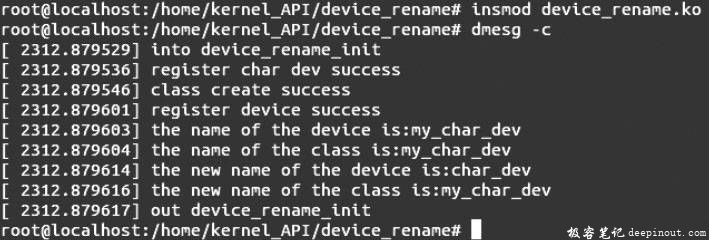函数device_rename()用于给已存在的逻辑设备重新命名,将逻辑设备的名字更新为此函数的第二个参数所代表的字符串,并重命名目录/sys/devices/virtual/下此逻辑设备对应的设备文件夹名。
如果内核中有宏CONFIG_SYSFS_DEPRECATED的定义,则此函数也能够更新此逻辑设备对应的设备类的名字,并重命名目录/dev下对应的设备文件名。
device_rename文件包含
#include <linux/device.h>
device_rename函数定义
在内核源码中的位置:linux-3.19.3/drivers/base/core.c
函数定义格式:
int device_rename(struct device *dev, char *new_name)
device_rename输入参数说明
- 函数
device_rename()的第一个参数是struct device结构体类型的指针,代表即将被重命名的逻辑设备,此结构体在极客笔记函数device_create()的说明文档中已详细说明。
-
第二个输入参数代表逻辑设备的新设备名,用于替换逻辑设备的设备名。
device_rename返回参数说明
- 此函数的返回值是int型的变量,可能的取值是0、-EINVAL、-ENOMEM,其中EINVAL的值为22, ENOMEM的值为12。
device_rename实例解析
编写测试文件:device_rename.c
头文件引用、全局变量定义及相关函数声明:
/*头文件引用*/
#include <linux/module.h>
#include <linux/init.h>
#include <linux/kernel.h>
#include <linux/slab.h>
#include <linux/vmalloc.h>
#include <linux/fs.h>
#include <linux/cdev.h>
#include <asm/uaccess.h>
#include <linux/types.h>
#include <linux/moduleparam.h>
#include <linux/pci.h>
#include <asm/unistd.h>
#include <linux/device.h>
#include <linux/kobject.h>
MODULE_LICENSE("GPL");
#define MEM_MALLOC_SIZE 4096 //缓冲区大小
#define MEM_MAJOR 245 //主设备号
#define MEM_MINOR 0 //次设备号
char *mem_spvm; //缓冲区指针,指向内存区
struct class *mem_class; //设备类指针
struct device *dev; //逻辑设备指针
static int __init device_rename_init(void); //模块加载函数声明
static void __exit device_rename_exit(void); //模块卸载函数声明
static int mem_open(struct inode *ind, struct file *filp); //设备打开函数声明
static int mem_release(struct inode *ind, struct file *filp); //设备关闭函数声明
/*设备读、写函数声明*/
static ssize_t mem_read(struct file *filp, char __user *buf, size_t size, loff_t *fpos);
static ssize_t mem_write(struct file *filp, const char __user *buf, size_t size,loff_t *fpos);
static void device_register_release(struct device *dev); //逻辑设备释放处理函数
/*定义设备驱动文件结构体*/
struct file_operations mem_fops =
{
.owner=THIS_MODULE, //结构体拥有者初始化
.open = mem_open, //设备打开函数
.release = mem_release, //设备关闭函数
.read = mem_read, //设备读函数
.write = mem_write, //设备写函数
};
模块加载函数定义:
int __init device_rename_init(void)
{
int res;
printk("into device_rename_init\n");
mem_spvm = (char *)vmalloc(MEM_MALLOC_SIZE); //开辟内存缓冲区
res=register_chrdev(MEM_MAJOR, "my_char_dev", &mem_fops); //注册字符设备
if(res) //注册失败
{
unregister_chrdev(MEM_MAJOR, "my_char_dev"); //删除字符设备
printk("register char dev failed\n");
return -1;
}
printk("register char dev success\n");
mem_class = class_create(THIS_MODULE, "my_char_dev"); //创建设备类
if(IS_ERR(mem_class)) //判断创建是否成功
{
printk("failed in creating class.\n");
class_destroy(mem_class); //失败,则销毁设备类
return -1;
}
printk("class create success\n");
dev=kzalloc(sizeof(*dev), GFP_KERNEL); //为逻辑设备开辟内存空间
/*初始化设备的设备号,包括主设备号和次设备号*/
dev->devt=MKDEV(MEM_MAJOR, MEM_MINOR);
dev->class=mem_class; //初始化设备类
dev->release = device_register_release; //初始化设备注销处理函数
res= kobject_set_name(&dev->kobj, "my_char_dev"); //初始化设备引用计数器
if(res)
{
printk("kobject_set_name_vargs failed\n");
kfree(dev); //失败,释放设备占用的内存空间
return -1;
}
res=device_register(dev); //将逻辑设备加入Linux内核系统
if(res)
{
printk("register device failed\n");
device_unregister(dev); //注册失败,释放逻辑设备
kfree(dev); //释放逻辑设备占用的内存空间
return -1;
}
printk("register device success\n");
printk("the name of the device is:%s\n", dev->kobj.name); //显示逻辑设备名
printk("the name of the class is:%s\n", dev->class->name); //显示逻辑类名
res=device_rename(dev, "char_dev"); //重命名逻辑设备
if(res)
{
printk("rename device failed\n");
}
/*显示函数调用之后的逻辑设备名*/
printk("the new name of the device is:%s\n", dev->kobj.name);
/*显示函数调用之后的逻辑类名*/
printk("the new name of the class is:%s\n", dev->class->name);
printk("out device_rename_init\n");
return 0;
}
模块退出函数定义:
void __exit device_rename_exit (void)
{
printk("into device_rename_exit\n");
unregister_chrdev(MEM_MAJOR, "my_char_dev"); //注销字符设备
if(dev)
{
printk("device unregister\n");
device_unregister(dev); //删除逻辑设备
}
printk("device unregister success\n");
if(mem_class)
class_destroy(mem_class); //删除设备类
printk("class destroy success\n");
if (mem_spvm ! = NULL)
vfree(mem_spvm); //释放内存缓冲区空间
printk("vfree mem_spvm OK\n");
printk("out device_rename_exit\n");
}
相关函数定义:
/*设备打开函数定义*/
int mem_open(struct inode *ind, struct file *filp)
{
printk("open vmalloc space\n");
try_module_get(THIS_MODULE); //模块引用自加
printk("open vmalloc space success\n");
return 0;
}
/*设备读函数定义,在此没有实际意义,因为不涉及设备的读*/
ssize_t mem_read(struct file *filp, char *buf, size_t size, loff_t *lofp)
{
printk("in the function mem_read\n");
return 0;
}
/*设备写函数定义,在此没有实际意义,因为不涉及设备的写*/
ssize_t mem_write(struct file *filp, const char *buf, size_t size, loff_t *lofp)
{
printk("in the function mem_write\n");
return 0;
}
/*设备关闭函数定义*/
int mem_release(struct inode *ind, struct file *filp)
{
printk("close vmalloc space\n");
module_put(THIS_MODULE); //模块引用自减
printk("close vmalloc space success\n");
return 0;
}
/*逻辑设备释放处理函数*/
static void device_register_release(struct device *dev)
{
pr_debug("device: '%s': %s\n", dev_name(dev), __func__);
kfree(dev); //释放设备占用的内存空间
}
模块加载、退出函数调用:
module_init(device_rename_init); //模块加载
module_exit(device_rename_exit); //模块卸载
实例运行结果及分析
首先编译模块,执行命令insmod device_rename.ko插入内核模块,然后输入命令dmesg -c查看模块插入结果,会出现如图A所示的结果。

然后执行命令ls /dev查看当前系统的设备文件,出现如图B所示的结果。

执行命令ls /sys/devices/virtual/my_char_dev查看逻辑设备目录,出现如图C所示的结果。

执行命令ls -l /sys/devices/virtual/my_char_dev/char_dev查看逻辑设备目录内容,出现如图D所示的结果。

执行命令rmmod device_rename.ko删除内核模块,然后输入命令dmesg -c,出现如图E所示的信息。

结果分析:
由图A可以看出逻辑设备被重命名成功,而此逻辑设备对应的逻辑类没有被重命名,说明内核中没有宏CONFIG_SYSFS_DEPRECATED的定义。图B可以说明逻辑类没有被重命名。图C和图D说明函数device_rename()在重命名逻辑设备的同时也会重命名逻辑设备在目录/sys/devices/virtual/my_char_dev/下对应的逻辑设备目录名,而对应的设备目录里面的内容不会更改。
 极客笔记
极客笔记